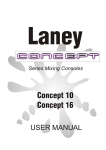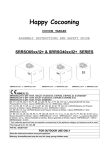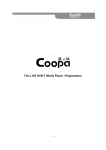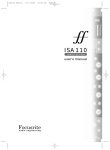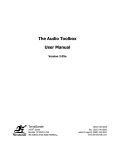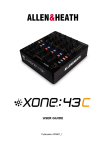Download Laney Amplification Concept 6 DJ Equipment User Manual
Transcript
Laney Series Mixing Consoles Concept 6 Concept 8 USER MANUAL Concept Concept 6 - Concept 8 2 User Manual TABLE OF CONTENTS Page 2 Page 3 Contents General Information Page 4 Page 5 Page 6 Page 7 Page 8 Page 9 Page 10 Page 11 Page 12 Page 13 Concept 6/8 Features Concept 6/8 Quick Start Guide Concept 6/8 Quick Start Guide Concept 6/8 Quick Start Diagrams Mic/Line Channel Information Mic/Line channel information (cont) Page 14 Concept 6/8 Technical Specifications Graphic Equaliser/DigiFx Information Masters Information Rear panel details Concept 6/8 Block Diagrams Concept Manual Concept THANK YOU We at Laney are extremely pleased that you have decided to select a Concept mixing desk for your mixing and we wish to reinforce your judgement by ensuring you get off to a flying start by including this comprehensive user manual to assist you in getting to know your equipment. 3 Before switching on please read this manual carefully since whilst you may well be an experienced user no two brands are the same, and on reading this manual you will become aware of the subtle advantageous differences that Concept offers over its UNPACKING On unpacking your Concept please check carefully for any signs of damage that may have occurred whilst in transit from the Laney factory to your dealer. In the unlikely event that there has been damage please repack your unit in its original carton and consult your dealer. We would strongly advise you to store away your original transit carton since in the unlikely event that some time in the future your unit should develop a fault, you will be able to return it to your dealer for rectification securely packed. IMPORTANT SAFETY INFORMATION Your mixer should be fitted with a three pin 'grounded' (or 'earthed') plug. Please make sure that the mixer is powered from a 'grounded/earthed' outlet. If changing or fitting a plug yourself, ensure that the applicable wiring code is adhered to, for example in the UK the cable colour code for connections are as follows: EARTH OR GROUND NEUTRAL LIVE GREEN/YELLOW BLUE BROWN The mixer should never be exposed to moisture or wetness under any circumstances since this would represent a possible shock or fire hazard, and may cause expensive damage to your valuable possession. In the unlikely event that a fuse should blow, it is imperative that you or your engineer, use a correctly rated replacement. Details of the fuse required is printed on the rear panel of the mixer, please take special care to use a 'time delay' fuse wherever stated. Concept Manual Concept Laney have been established in audio amplification for over twenty five years, during which time it has firmly established itself as a benchmark for audio products. SPECIAL FEATURES 6 Mic/Line channels Concept 6 4 8 Mic/line channels Concept 8 Feedback from musicians and recording engineers, supported by original design ingenuity, are the parameters applied by Laney's development engineers to all new products. 2 * 150 Watt Output Power 2* 100 Watt Output Power 6 Band Graphic EQ On Board Digital Reverb (Concept 8) Phantom Power Concept mixers explained within this manual are easy to use but incorporate features which make advanced set ups easy in any role. Sub-mixing 3 Band EQ - Main P.A. - Monitors Mon/Digifx sends The mixer in this manual have a combination of Mic/line inputs and Mic/Stereo channels for extra flexibility. 1 2 3 4 5 6 7 Pfl facilities 8 STEREO GRAPHICS PHANTOM POWER TAPE OUTPUT MON 80Hz MIC MIC MIC MIC MIC MIC MIC 200Hz 600Hz 1K2Hz 3KHz LEFT 10KHz +8dB MIC RIGHT +8dB FX TAPE INPUT 0dB LINE LINE MIC/LINE PAD 4 5 8 GAIN 1 0 1 0 HF EQ 1 2 3 1 0 MID 4 5 2 1 PRE (POST) 2 8 10 PRE (POST) 10 5 6 2 8 (POST) 1 6 2 10 8 (POST) 0 1 3 3 4 PAN PFL 8 (POST) 1 3 PAN PFL 1 PAN 0 PFL 0 3 3 4 5 PAN 1 PAN PFL 2 PROGRAM 8 1 Hall Dark Hall Room Dark Room Plate Dark Plate Reverse Reverb Gated Reverb 10 0 4 1 3 7 8 1 MON 5 PFL Delay Regen Delay 6 2 4 5 5 3 2 4 PFL 8 6 3 7 2 8 1 9 0 10 TAPE TO MASTER MASTERS RIGHT/PFL LEFT 8 (POST) 3 PAN 7 9 10 5 STEREO AUXILIARY INPUTS 9 1 5 8 4 3 2 PEAK 7 0 4 5 7 9 10 7 Long 9 2 3 4 5 4 5 6 6 1 TAPE 0 TO MON MON 6 4 FX 2 10 FADER 6 2 1 3 4 5 PRE (POST) 10 5 1 10 0 2 2 8 4 8 (POST) 0 5 3 2 7 0 9 0 1 3 4 5 2 10 0 Short 3 3 FX 1 6 1 7 8 0 8 10 4 7 9 9 MON 6 5 6 1 5 TIME 2 10 5 1 9 2 2 PFL PFL 8 (POST) 1 1 4 PAN 4 3 7 4 3 2 1 6 7 0 5 3 PRE (POST) 9 0 6 2 10 0 3 3 5 10 5 FX 1 4 5 8 (POST) 8 MON 4 9 2 2 4 5 2 2 5 1 3 5 4 2 1 2 4 7 INPUT 3 LEVEL 4 5 6 1 9 0 3 7 FX 1 3 4 5 1 PRE (POST) MON 6 5 3 0 Laney Concept 8 2 4 4 LO 4 1 3 5 EQ 5 2 3 3 7 0 5 1 2 4 5 LO 8 1 4 6 2 10 5 1 10 0 2 3 4 5 8 (POST) 9 0 2 PRE (POST) 9 4 FX 1 3 4 5 2 1 3 7 5 0 3 5 1 MID 1 3 5 4 8 10 HEADPHONE LEVEL 3 3 7 9 0 RIGHT 2 2 3 4 5 5 2 2 3 MON 6 1 HF 2 4 MID EQ 1 3 4 4 8 0 5 6 2 3 1 7 0 10 5 1 10 0 2 2 4 5 4 3 9 0 1 3 4 5 0 9 0 7 FX 1 2 2 PRE (POST) MON 6 2 10 FX 1 2 1 10 5 1 9 0 FX 9 4 3 7 1 9 0 5 8 5 1 0 6 1 4 5 5 2 1 4 5 5 0 3 4 2 2 4 4 LO EQ 1 3 5 HF 5 5 2 3 3 7 2 MID 2 4 6 1 0 4 4 5 LO 5 5 3 1 4 5 3 PRE (POST) MON 4 3 7 8 0 MON 4 3 2 0 2 3 3 5 3 4 4 3 10KHz 10 2 3 3KHz 9 1 2 1K2Hz 8 0 1 HEAD PHONES LEFT MONO 600Hz 7 GAIN 0 3 4 2 2 4 5 5 1 1 2 4 7 MID EQ 1 4 4 5 6 1 9 0 MON 5 0 4 LO 4 1 HF 1 2 3 -8dB 200Hz 6 1 10 -8dB 80Hz 2 9 GAIN 2 5 3 8 0 1 4 5 0 0 3 4 3 3 1 2 3 4 7 1 10 STEREO MIC/LINE PAD 6 2 9 GAIN 2 5 8 0 1 2 2 4 3 5 EQ 1 2 3 HF 5 5 1 2 4 5 0 4 1 3 7 1 3 MID 0 5 5 0 4 4 2 3 1 LO HF 2 4 4 6 1 9 0 5 1 3 5 EQ 5 5 2 3 4 8 MID 2 3 7 1 0 1 3 3 4 3 7 1 10 2 2 6 5 0dB LINE MIC/LINE PAD 2 9 GAIN 1 4 5 4 4 5 LO 4 5 0 3 8 0 10 2 3 3 1 4 6 3 0 3 5 5 3 1 2 2 2 4 1 3 4 EQ 5 5 2 2 4 HF 1 4 1 2 3 PAN 1 0 1 4 5 5 9 0 4 5 3 7 1 LINE MIC/LINE PAD 6 2 8 GAIN 0 3 4 3 4 5 5 1 2 3 4 5 3 7 1 10 LINE MIC/LINE PAD 6 2 9 GAIN 2 5 3 8 0 1 2 2 4 0 4 5 3 LO 1 3 4 5 10 4 7 1 LINE MIC/LINE PAD 6 2 9 2 3 4 8 GAIN 2 4 5 3 7 0 1 2 3 6 1 10 LINE MIC/LINE PAD 2 9 0 MID 4 5 3 7 1 HF MIC/LINE PAD 6 3 2 LINE +6dB +6dB +3dB +3dB OdB OdB -3dB -3dB -6dB -6dB -9dB -9dB -12dB -12dB 9 0 10 PFL -15dB -15dB -18dB -18dB -21dB -21dB PFL ACTIVE OdB OdB OdB OdB OdB OdB OdB -6 -6 -6 -6 -6 -6 -6 -6 -10 -10 -10 -10 -10 -10 -10 -10 -20 -20 -20 -20 -20 -20 -20 -20 -30 -30 -30 -30 -30 -30 -30 -30 1 - 2 - 3 - 4 - 8 - 5 - 6 - 7 - 8 +10 +6 +6 +6 OdB OdB OdB -6 -6 -6 -10 -10 -10 -20 -20 -20 -30 -30 -30 - DIGITAL FX - LEFT +10 - 8 OdB +10 8 +6 8 +10 +6 8 +10 +6 8 +10 +6 8 +10 +6 8 +10 +6 8 +10 +6 8 +10 +6 8 +10 RIGHT Concept Manual Concept Concept 6/8 Quick Start Guide This is a quick start guide so you can be using you mixer sooner rather than later - you can then refer to the detailed description later in this manual when you need. 2 diagrams are provided to supplement this information following these tips 5 Plugging in ! Connect power to your mixer - always a good start ! Switch On Connect all you input signals Mics/DI's/Keyboards/Tape machines to there relevant input channels Connect your condenser Mics before enabling Phantom power **Do not connect dynamic Mics or unbalanced sources to mic inputs when Phantom power is enabled otherwise damage may occur to your them or your mixer** Its a good idea to label up each channel strip, so you know what is connected where - this can be done in chinagraph in the `write on' areas or use a piece of masking tape along the front edge of the mixer (the old favourite) Its always good practice to start work on mixer with all gain controls at minimum ,all faders at minimum and all EQ set flat. Input Channel Do not be intimidated by the input channels on your mixer as it's function is very simple:1)The gain control - makes little signals big, so they are as far above noise as possible but not so high that the signal is clipped - the peak led illuminates when clipping is near. 2)The EQ section - tonally changes the input signal , this is just like the tone controls on your Hi -Fi but with more knobs. The controls are labelled-Hi , Mid(gain + Frequency) and Lo controls 3)It lets you send the signal to places of use e.g. A Monitor send for a vocalists/Musician Aux 1 and Digifx if you want to add echo/reverb to a signal. These send controls are labelled Mon, Aux 1 and Digifx 4)You can adjust the signals position in the stereo image using the Pan control. 5)Fader - this controls the signal level being sent to Masters Setting the gain on an Input Channel By now you will have connected your input signals to your mixer and be ready to set your input gain controls. 1)Enable Pfl on the channel which you wish to set up - the right meter shows the signal level in that channel and the channels signal appears on the headphones 2)Tell the vocalist/musician to play - while he plays you should set the channel gain control so that 0dB to +6dB will illuminate on signal peaks 3)Increase the channel fader to between -10 and OdB and then increase the masters faders to a level which is a satisfactory volume - power amp level control should be about -6db. 4)This point is a good time to set the EQ - remember if you boost a lot you will have to reset the input gain control as described in 2) FX Certain instruments will benefit from the addition of some form of effect for instance snares can be made sound `bigger' with the addition of a reverb or maybe a vocal could be thickened up with a bit of delay. Concept Manual Concept You can send signals to FX using the Aux 1 and Digifx controls on the channels . The Aux 1 master send control adjusts the overall level sent to external FX units via the Aux 1 output socket . Signals from external FX units should be returned by the Stereo auxiliary - a rotary fader is then used to control the level of FX signal sent to masters, enabling a mix to established between FX signal and signal without FX 6 The Digifx control sends signals to the Digifx section. The input level control on the DigiFx should be set so the Peak light in the DigiFx section is just prior to it illuminating, like the Stereo auxiliary, a fader is provided to control the FX signal sent to the masters. Time to mix One way to do this is to increase all the input channels to approx. -10dB to 0dB. Ask the band to play, Increase the master faders for to a satisfactory volume level. Adjust the input channel faders so there level relative to other instruments sounds good - e.g. the keyboard player does not sound louder than the lead vocalist. You can also adjust the position of an instrument in the stereo image - e.g. to bring a vocalist out in the mix, you could pan all other signals Left or Right by varying amounts. A graphic equaliser is provided allowing the overall sound of your mix to be fine tuned . Feedback As you set up your mix you will probably have problems with feedback. This occurs when microphones pick up sound from the loudspeakers creating a loud whistling/howling sound - very disturbing Here are a few ways to prevent this 1)make sure the sound from the speakers ,connected to your Mixers speaker outs, cannot be picked up by microphones .( speakers are best in front + facing away from the band) 2)Keep the faders down on microphones which are not needed. 3)Try to cut rather than boost when using any EQ. 4)If feedback does occur use the channel EQ /graphic EQ to stop it, this can be done by cutting at the frequency which the feedback occurs. A feedback filter is provided on the monitor send Recording If you want to record your mix a tape out is provided to connect to tape/DAT/MD/DCC machines. The line out / tape out level controls the level sent to the tape machine. Finally................ Following this section follows more some quick set-up diagrams and more detailed information about your Concept mixer's facilities. Good luck with your mixing ! Concept Manual Concept CONCEPT 6 / 8 Quick Set Up Guide connect your active/powered monitor here Amp miked Up Connect more Vocals here 7 La ne y Connect Vocals here O O O O O.O Laney connect tape/DAT/CD here for playback connect mic'd up guitar/Bass cabinet here connect Keyboards, Synths etc here connect tape/DAT machine here for recording FX output to FX unit input FX unit output to Stereo Auxiliary Input D.I. your Guitar/ Bass here 1 o o 2 3 4 5 6 7 O O 8 O O O FX PROCESSOR o o STEREO GRAPHICS PHANTOM POWER TAPE OUTPUT MON 80Hz MIC MIC MIC MIC MIC MIC MIC 200Hz 600Hz 1K2Hz 3KHz LEFT 10KHz +8dB MIC RIGHT +8dB FX TAPE INPUT 0dB LINE LINE MIC/LINE PAD 4 5 3 9 1 0 3 0 2 EQ 1 0 2 4 5 4 2 8 1 PRE (POST) 9 0 6 4 8 1 PRE (POST) 5 6 2 8 (POST) 1 9 0 5 4 8 (POST) 0 1 3 4 0 1 3 4 5 PAN PFL 1 0 4 5 PAN PFL 4 5 3 PAN PFL 5 5 PAN PFL 5 10 0 5 PAN 1 3 4 5 5 PAN PFL 5 8 2 PROGRAM 1 Dark Room Plate Dark Plate Reverse Reverb Gated Reverb 10 0 4 1 7 8 1 4 MON 5 PFL Delay Regen Delay 6 2 3 5 5 3 2 4 PAN 1 Hall Dark Hall Room 9 0 5 8 4 7 8 9 10 10 5 6 3 7 2 8 1 9 0 10 TAPE TO MASTER MASTERS RIGHT/PFL LEFT 8 (POST) 2 PFL 6 3 7 9 TAPE 0 TO MON 2 6 1 STEREO AUXILIARY INPUTS 7 3 4 5 5 3 2 7 Long FX 3 4 PEAK 6 1 2 4 4 PRE (POST) 10 5 2 1 3 10 6 9 0 10 0 2 2 0 MON FADER 9 10 Short 3 8 3 9 8 5 4 4 7 9 7 1 8 (POST) 0 1 4 PFL 2 5 6 1 0 8 MON 7 4 3 2 1 6 7 0 TIME 6 2 6 FX 1 3 4 PRE (POST) 10 5 1 9 0 3 4 4 4 5 3 9 0 8 (POST) 2 2 8 3 7 1 1 4 7 1 6 2 10 0 3 6 2 10 5 FX 1 2 2 4 5 9 5 5 1 3 4 5 5 4 2 2 4 MON 4 8 (POST) 0 1 PRE (POST) 9 0 3 7 2 10 0 8 1 6 FX 1 3 4 INPUT 3 LEVEL 1 3 LO 3 7 0 2 3 4 5 5 6 2 10 5 1 9 5 1 2 4 LO MON 4 8 (POST) 2 3 PRE (POST) 9 0 3 7 FX 2 8 1 6 1 1 3 4 5 0 2 2 3 4 5 9 4 3 7 1 3 4 5 5 0 2 3 4 6 2 10 5 2 10 5 1 2 3 LO MON 4 FX 1 2 2 PRE (POST) 9 0 3 8 (POST) 0 8 1 3 4 1 3 4 5 5 Laney Concept 8 2 4 MID EQ 1 3 4 5 5 5 2 3 4 8 10 HEADPHONE LEVEL 3 0 7 9 0 RIGHT 2 5 5 6 1 4 1 2 3 MID EQ HF 4 3 10KHz 2 1 4 1 2 3 0 0 0 3 5 5 1 2 4 2 2 EQ 5 5 1 4 HF 3KHz 10 2 3 1K2Hz 9 1 2 4 600Hz 8 0 1 4 1 4 5 5 3 7 MON 7 2 10 2 0 3 MID 1 4 LO 6 2 6 1 9 0 FX 1 2 3 PRE (POST) 10 5 5 3 9 0 3 7 1 FX 8 6 2 10 2 10 4 7 MON 4 3 7 6 1 9 0 MON 4 3 5 3 7 2 10 MON PAN 5 3 7 0 3 4 1 0 3 5 5 2 3 4 5 5 1 5 5 EQ 2 4 3 4 LO HF 1 3 HEAD PHONES LEFT MONO 200Hz 7 GAIN 2 2 4 -8dB 80Hz 1 10 -8dB 6 2 9 0 5 3 8 GAIN 1 4 1 3 MID 2 3 4 5 5 0 0 3 5 5 1 1 2 3 4 0 3 2 3 4 5 5 1 2 3 LO EQ 2 4 1 HF 1 2 2 4 4 7 1 10 STEREO MIC/LINE PAD 6 2 9 0 1 4 1 3 MID 2 3 4 0 0 3 5 5 2 3 0 3 4 1 2 4 5 5 1 5 5 EQ HF 1 2 2 4 8 GAIN 5 3 7 1 10 4 0dB LINE MIC/LINE PAD 6 2 9 0 5 3 8 GAIN 1 3 1 4 2 4 0 3 MID 1 3 LO 6 3 0 2 3 4 5 5 1 0 2 3 2 3 1 2 4 5 5 EQ 4 1 2 4 HF 5 5 1 4 2 4 0 3 1 3 MID 1 3 0 2 3 4 5 5 1 3 10 4 7 1 LINE MIC/LINE PAD 6 2 9 0 5 3 8 GAIN 2 2 4 5 5 1 2 4 enable pfl and set gain for 0dB on meters HF GAIN 4 7 1 10 LINE MIC/LINE PAD 6 2 9 0 5 3 8 1 4 1 3 0 3 4 5 5 1 LO 1 2 2 4 4 7 1 9 LINE MIC/LINE PAD 6 2 10 GAIN 5 3 8 0 1 2 3 4 7 1 LINE MIC/LINE PAD 6 2 10 GAIN 5 3 8 0 MID 4 7 1 HF MIC/LINE PAD 6 2 LINE +6dB +6dB +3dB +3dB OdB OdB -3dB -3dB -6dB -6dB -9dB -9dB -12dB -12dB -15dB -15dB -18dB -18dB -21dB -21dB meters 9 0 10 PFL PFL ACTIVE OdB OdB OdB OdB OdB OdB OdB -6 -6 -6 -6 -6 -6 -6 -6 -10 -10 -10 -10 -10 -10 -10 -10 -20 -20 -20 -20 -20 -20 -20 -20 -30 -30 -30 -30 -30 -30 -30 -30 1 2 - 3 - 4 - 5 - 6 - 7 - 8 8 - 8 - +10 +10 +10 +6 +6 +6 OdB OdB OdB -6 -6 -6 -10 -10 -10 -20 -20 -30 -30 -20 -30 - DIGITAL FX - LEFT - Set Output Volume level here 8 +6 OdB +10 8 +6 8 +10 +6 8 +10 +6 8 +10 +6 8 +10 +6 8 +10 +6 8 +10 +6 8 Set between -10dB + 0dB +10 RIGHT Concept Manual Concept MIC / LINE CHANNEL (MONO) 1 1) 1 The input socket has been designed to accept both balanced and unbalanced signals from microphones with an XLR input connector. Good quality low impedance condenser or dynamic mic's should preferably be used for best results, these will ensure the best possible results from hand held vocals or closely mic'd MIC 2 LINE 4 5 3 7 9 0 10 GAIN 1 0 2 3 3 4 4 5 5 1 0 2 3 3 4 MID 4 5 5 1 0 3 The balanced line inputs are for all balanced/unbalanced line level signals from keyboards, drum machines,tape machines and DI boxes. (eg; from guitars and basses) 4 5 5 4 5 6 3 7 2 8 1 PRE (POST) 9 0 3) 10 MON 4 5 6 3 8 (POST) 1 9 0 10 FX 1 0 1 2 2 3 4) 3 4 4 5 MIC/LINE PAD This reduces high signal level before they enter the input amplifier. This allows close mic'd instuments such as lead guitar cabs ,kick drums and lead vocalists to be be amplified without distortion. 7 2 PAN LINE INPUT (JACK) 2 4 LO 2) 1 2 3 5C EQ 1 2 5B Phantom power must always be switched off when using unbalanced sources since the voltage present on the connector may damage your microphones The phantom power switch is on the rear panel with an indicator LED near the graphic equaliser. Always connect your condenser microphones before switching the +48V 1 2 HF WARNING 8 1 5A Phantom powering is available to all 'mic' inputs for use with condenser microphones 6 2 4 8 PHANTOM POWER MIC/LINE PAD GAIN Adjusts the level of the input signal into the channel. It should be set so that the input signal is not buried in noise but not too high so that clipping ocurrs,the peak lamp will illuminate to indicate this. 5 PFL 5) EQUALISATION On Mic/Line channels there is a three band EQ system ,detailed below +10 +6 OdB 5A) HI High/Treble frequencies can boosted or cut by this control.Sources that fall in this range are cymbals,soprano vocals and keys above top C on a keyboard. -6 5B) Mid -10 -20 -30 - 8 3 MIC INPUT (XLR) Mid range frequencies can be boosted or cut by this control.The frequency of cut is between middle C and top C .Music sources which fall in this range are most Vocals ,lead/rythmn guitar , keyboard parts and brass sections. 5C) LO 1 Low/Bass frequencies can be boost or cut by this control such as bass guitar,kick drums,deep[ vocals and keys below middle C on a keyboard. Concept Manual Concept MIC / LINE CHANNEL (MONO) 1 6) MON The Mon control is set for pre-fade operation for use as a monitor send MIC 7) MIC/LINE PAD 4 5 6 3 7 8 1 9 0 10 GAIN 1 0 2 4 0 EQ 1 2 2 3 3 4 4 5 5 1 0 9) 1 2 2 3 4 5 5 4 5 6 3 7 2 8 1 PFL (Pre-fade listen) The pre fade listen switch when depressed sends the 'pre fader' channel signal to the right hand meter (VU) and headphones, allowing channel 'Gain' to be set and cued. This is non destructive so may be used at any time during the performance without effecting the main mix output. 3 4 6 Assigns (Pans) the channel signal across the left and right master outputs,the signal being sent equally left and right when set central 5 5 1 LO PAN 3 4 MID 8) 1 2 3 HF FX Is a 'post fade' send ,it traditionaly being used as an FX send.The signal leaves by the socket marked FX. On the Concept 8 mixer the FX control sends signals to the Internal digital FX in addition to the socket marked FX. The mount of FX signals returned to the Masters is controlled by the DigiFx fader for the internal FX and the Stereo Auxiliary Fader for external FX units LINE 2 9 PRE (POST) 9 0 10 MON 4 5 6 3 7 7 2 8 (POST) 1 9 0 0 1 2 8 2 3 3 4 PAN 9 FADER The channel fader sets the output level of the channel sent to the MASTERS . The relationship between the 'fader' and the channel 'gain' controls is important and this is explained in detail in the setting up procedure section. FX 1 10) 10 4 5 5 PFL +10 +6 OdB 10 -6 -10 -20 - 8 -30 1 Concept Manual Concept STEREO GRAPHICS A Graphic Equaliser is provided for fine tuning of mixes and room acoustics Centre frequencies are 80Hz,200Hz,600Hz,1.2KHz,3KHz and 10.5KHz. Varying the 80Hz / 200Hz filters adjusts bass frequencies Varying the 600Hz,1.2KHz and 3KHz adjusts midrange frequencies. Varying the 10.5KHz adjusts treble frequencies. STEREO GRAPHICS PHANTOM 80Hz 200Hz POWER 600Hz 1K2Hz 3KHz 10KHz +8dB +8dB 0dB 0dB -8dB 80Hz The Graphic Equaliser is the last place the L + R Masters pass through before amplification by the internal power amplifiers. -8dB 200Hz 600Hz 1K2Hz 3KHz 10 POWER 10KHz This lamp illuminates when power is connected to your mixer and it is turned on. A Power switch is located on the rear panel. PHANTOM 11 INPUT 3 LEVEL 5 4 7 2 8 1 9 0 10 PEAK 5 TIME 12 This lamp illuminates when phantom power is connected to all the microphone inputs. Phantom power is switched on using a rear panel slide switch. 6 4 6 2 8 DIGITAL EFFECTS 7 Long Short 3 PROGRAM 1 Hall Dark Hall Room 11) INPUT LEVEL This controls level of the signal into the built in Effects processor.This provides the user the ability to achieve the best signal to noise performance of the effects unit. There is peak led near this control to show that the Effects processor is near clipping. Dark Room 13 Plate Dark Plate Reverse Reverb Gated Reverb 4 5 6 7 2 8 1 MON 9 Delay Regen Delay 6 3 9 0 12) TIME 13) PROGRAM 10 PFL The above controls allows the selection of 1 of the 127 available programs.These programs are arranged into 8 types selectable by the `Program' control. Different program times can then be selected using +10 +6 OdB MON The Mon control enables the user to send the effects signal to the monitor output -6 -10 -20 -30 - 8 14 6) DIGITAL FX 9) PFL In common with all other inputs PFL facilities are provided for the setting up of the effects.When PFL is enabled the signal from the effects unit is displayed on the right meter and is played in the headphones 14) FADER (Pre-fade listen) The `EFFECTS' fader controls the level of the effects signal sent to the Masters. Concept Manual Concept MASTERS 15) MON The signal from all the Mon send controls leave the mixer 16) FX TAPE OUTPUT 15 20 MON LEFT 16 RIGHT 21 FX The signal from all the FX send controls leave the mixer here. On the Concept 8 mixer the FX signal is also routed to the internal digital FX processor.This enables two FX to be used with your mixer. Signal from external FX processors return via the 11 TAPE INPUT 17) STEREO AUXILIARY INPUT SOCKETS STEREO 17 22 HEAD PHONES LEFT MONO 4 5 6 3 7 2 8 1 9 0 RIGHT 23 10 18) MON HEADPHONE LEVEL 4 5 6 3 18 4 7 2 8 1 9 0 10 4 5 19 2 8 1 7 8 1 9 4 7 9 0 3 6 3 10 FADER 6 2 TAPE 0 TO MON MON 5 21 10 5 The Fader controls the level of the Auxiliary input signal routed to the L and R masters. 7 2 8 9 0 10 TAPE TO MASTER 20) TAPE OUTPUT SOCKETS STEREO AUXILIARY INPUTS Phono (RCA) sockets are provided for the connection of tape / DAT machines for recording. The signal here is the the same as that sent to the internal power amps. MASTERS RIGHT/PFL LEFT 25 +6dB +6dB +3dB +3dB OdB OdB -3dB -3dB -6dB -6dB -9dB -9dB -12dB -12dB -15dB -15dB -18dB -18dB -21dB -21dB 21) TAPE INPUT Phono (RCA) sockets are provided for the connection of tape/DAT machines. The signal to monitor and master outputs can be independently controlled via the controls labelled 'Tape to monitor' and 'Tape to master'. 22) HEADPHONE SOCKET Connect your stereo headphones here. PFL ACTIVE 24 +10 +6 +6 OdB OdB -6 -6 -10 -10 -20 -20 -30 -30 - LEFT - 8 +10 8 26 Controls the Auxiliary input signal routed to the monitor 19) FADER 6 3 1 Stereo Auxiliary Input is provided for use as an FX return or as an additional stereo input . Stereo signals can be input either on a stereo jack or L + R on mono jacks.If required the Auxilary can be used as a mono input by inputting on the socket labelled Mono. RIGHT 23) HEADPHONE LEVEL Adjusts the headphone volume level The signal on the headphones is the same signal being sent to the power amplifiers When a channels PFL switch is enabled the channel signal (pre-fade) is routed to the headphones. 24) PFL ACTIVE Indicates that a PFL switch has been enabled thus routing a PFL signal to the headphones and right meter. 25) MASTER METERS The master meters show the signal level at the power amp inputs. When pfl is enabled the right meter shows the pfl signal level.The maximum signal level to the power amps should be peaks of +3 to +6 on the meters. 26) MASTER FADERS These are the final level control before the power amps and tape output. Concept Manual Concept Rear Panel Facilities 12 DO NOT OBSTRUCT AIR OUTLET 27) MIXER COOLING 5C Please observe all recomendations on cooling. Air is sucked in through vents on front edge of your mixer,it is then blown out by the fan . Do Not Obstruct Vents Or Fan Aperture Or You Risk Thermal Shutdown Of Your Mixer In the event of thermal failure ,Do not switch your mixer off as it will automaticaly reset after few minutes.Switching the mixer off,switches the fan off thus stopping cooling. 28) SPEAKER OUTPUTS The Concept 8 mixer is able to deliver 2 * 150W into 4 Ohms The Concept 6 mixer is able to deliver 2 * 100W into 4 Ohms Under no circumstances should the total load seen by any of the amplifiers be below 4 ohms otherwise thermal shutdown is likely and long term reliability may be impaired. 8P-8601 MADE IN THE UNITED KINGDOM BY BLT Industries Ltd 300W Powered Mixer Laney Speaker jack connector are provided for the connection to loudspeakers. 29) 48V Phantom MINIMUM LOAD 4 OHMS LEFT CHANNEL OUTPUT POWER 150 WATTS SPEAKER OUTPUTS 28 29 ATTENTION CAUTION TO AVOID FIRE HAZARD REPLACE ONLY WITH SAME TYPE AND RATING REMPLACER LE FUSIBLE PAR LE MEME ET LE CALIBRE ~ 600 WATTS 50/60Hz~ MAXIMUM POWER CONSUMPTION SUPPLY VOLTAGE = 230V POWER FUSE RATING 230V = T3.15A 100-120V = T6.5A O WARNING THIS APPARATUS MUST BE EARTHED ON It is globaly switched to all mic XLR sockets via this recessed switch. OFF RIGHT CHANNEL MINIMUM LOAD 4 OHMS CONDENSER MICS DEBRANCHER A LA PRISE SECTEUR AVANT D'OUVRIR I I PHANTOM POWER FOR ATTENTION AVIS CAUTION DISCONNECT POWER CORD BEFORE REMOVING COVERS RISQUE DE CHOC - NE PAS OUVRIR CAUTION REFER SERVICING TO QUALIFIED PERSONNEL WARNING TO REDUCE THE RISK OF FIRE CAUTION OR ELECTRIC SHOCK DO NOT REFER TO USER MANUAL EXPOSE THIS APPLIANCE TO BEFORE USING THIS APPARATUS RAIN OR MOISTURE 31 OUTPUT POWER 150 WATTS 48V Phantom Power is provided for condenser microphones. Phantom power must always be switched off when using unbalanced sources connected to mic inputs otherwise the source may be damaged 30) MAINS INLET 30 Power connection is provided on a 3 pin IEC mains connector.Never disconnect the ground from your mixer as this is potentialy lethal.. 31) MAINS SWITCH Switches the amplifier on and off. 32) MAINS FUSE The mains fuse is a 20mm Time delay fuse. See rear panel for fuse rating 32 Concept Manual Concept MIX NOISE (measured 22Hz-22K,RMS,TAPE OUT) Master Up -74Bu 1 Channel 0dB -78dBu All channels 0dB -77dBu 13 MIC CHANNEL (Fader 0dB ) MIC INPUT: Gain Max. 60dB + 10dB @ fader buffer Gain Min . 0dB + 10dB @ fader buffer Bandwidth 30Hz-20kHz -1dB E.I.N. (Equivalent Input Noise) -129dB (150R source Z) Distortion (mic to insets) typicaly <0.009% Maximum input +20dB Input Impedance 2K LINE INPUT: Gain Max. +17dB + 10dB @ fader buffer Gain Min. -38dB + 10dB @ fader buffer Bandwidth 30Hz-20kHz -1dB EQ: HI +/-12dB @ 12kHz (Shelving) Mid +/-12dB @ 2KHz (Q = .25) Lo +/-16dB @ 80Hz (Shelving) TAPE INPUTS (Ref +4dBu @ Output/Fader 0dB) Gain 15dB TAPE OUTPUT LEVEL +4dBU nominal MAXIMUM OUTPUT LEVELS Main Outputs (unbalanced) +22dBu Aux Output +22dBu Mon Output +22dBu POWER AMPLIFIER Power rating 2*150W into 4 Ohms (R.M.S) Hum and Noise -100dBu (22Hz-22KHz) Distortion <0.01 Slew Rate 20V/us Sensitivity +4dB Protection Short Circuit,Load Mismatch,Thermal,D.C. POWER CONSUMPTION 230V/115V40/60Hz 1000 Watts DIMENSIONS Concept 10 Concept 16 width 454mm 454mm depth 400mm 400mm height 191mm 191mm Concept Manual













